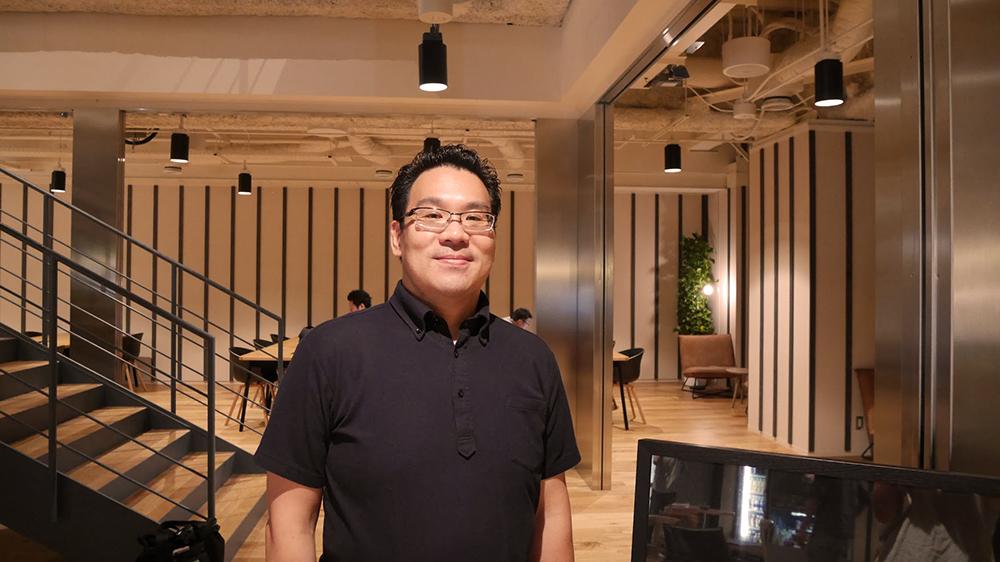What are the possibilities for visual content? What sort of hardware will people enjoy videos on in the future? Or will there be no hardware? How will viewers and creators adapt to these changes? A conference was held at WeWork in Roppongi Hills on June 12, 2018, to discuss the future of visual contents and hardware.
Various topics were debated in an open and sharing format with the participants, featuring Airi Kikuta, a film artist creating a variety of visual works primarily for the fashion and cosmetics industry, Noriyuki Igarashi, representative director of CREARC Inc., soon to launch the sharing app "Totte" specializing in video shooting equipment and tools, and Akira Taniguchi, Project Leader of Ambient Media Player (AMP) Living Space Displays for the Game Changer Catapult.
This is a report on this discussion by these three people all fascinated by visuals but involved with them in different ways: a maker of films, a platformer supporting film makers, and a maker of hardware used by film makers.
From left, Taniguchi, Mr. Igarashi and Ms. Kikuta
A shared desire to use visuals for interiors leads to a moment of empathy
Taniguchi: When I introduced myself to Ms. Kikuta for the first time, I said "I work for AMP Living Space Displays," and she said "That's amazing!" which quite surprised me.
Kikuta: I was amazed to the point of tears (laughs).
Taniguchi: I've never made anyone else cry just by introducing myself (laughs), what impressed you so much?
Kikuta: I used to work for a major interior company and also as a visual jockey (VJ) before becoming a film maker. I've spent over ten years wanting to work with visuals in interiors, so I was really touched to finally be able to achieve it like this.
Taniguchi: Now I see. You've been working with visual content from software; I've been working in an approach from video equipment hardware. I've thought that both visuals and the hardware that produces them can be parts of interior design. It's incredible to meet someone else with the same idea.
I'm often asked why I focus on visuals when creating spaces. Visuals are difficult to prepare, but they have a powerful impact on the five senses; they can make us sense things and move our emotions. I'd like to see that fascinating power installed in more places throughout the world.
Kikuta: My formative experience when I was young was seeing the ceiling of the dining hall in the Harry Potter movie turn into a starry sky and chandeliers through magic, and thinking to myself that the same thing could be done without magic. I thought that if you could change the way the ceiling looked, you could do it for three sides at a time, including walls. That was when I started to feel the power of visuals.
Taniguchi: By the way, what are those visuals of yours being shown today in the AMP of the venue?
Kikuta: They're advertising visuals, mostly for fashion and beauty.
Taniguchi: They have a fresh look that makes you want to keep watching them, forgetting they're actually ads.
Kikuta: If you think that, it's probably because they don't have a story. My idea is to emphasize a sense of flipping through a series of photos and gaining impressions from each picture, rather than following a story.
Taniguchi: But when you say they don't have a story, don't you worry that people might not watch them with the same level of attention as ordinary TV contents?
Kikuta: I'm not really worried about that. I make them with attention to the images.
Taniguchi: I think that the contents you make might go well with the world of AMP that I want to create, because visuals for interiors need to be designed not to make people concentrate on them.
Kikuta: That's true. AMP has the potential to create images like a warm fire burning in a welcoming hotel lobby, or visuals of water flowing in a Japanese restaurant. There are so many ideas for amazing visuals to make people feel relaxed and positive about; I think there are limitless ways these could be used.
Taniguchi: Thank you for saying that. I hope we can work together in the future.
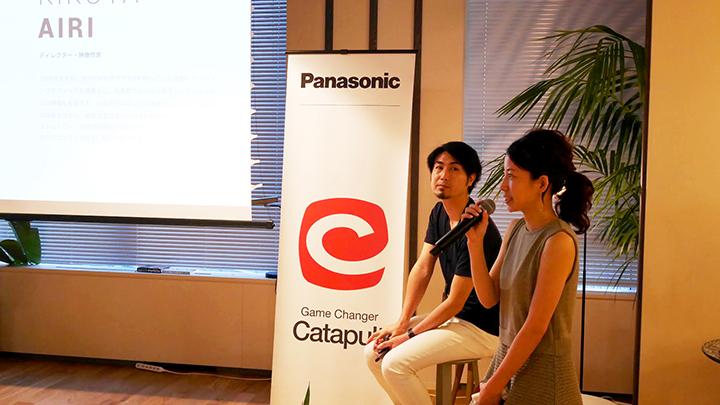
Taniguchi: Mr. Igarashi, what are your thoughts on how to make videos that serve to enhance the look of places?
Igarashi: I think Japanese advertising agencies could make visuals like these. But it might be hard for an individual to make them. This is because of the high cost of the equipment involved, and the different fashions for visuals in Japan versus elsewhere. The trend in Japan now is to edit interesting videos on YouTube. But elsewhere Vimeo, another video platform, is often used, with much more of an emphasis on artistic visuals. It's very common for individual creators make and upload these visuals themselves.
Taniguchi: There are certainly a lot of good videos to see on Vimeo. When we made the first prototype for AMP, we looked for visuals on Vimeo to project the sort of atmosphere we wanted to achieve. When we saw what was available, we were very impressed. I could see the potential for the sort of things we wanted to create, and I still have that sense of potential now.
A time will definitely come when each person is a creator
Taniguchi: Mr. Igarashi, you mentioned earlier that video equipment is expensive. You actually have a sharing service for professional equipment, is that right? Professional equipment is extremely pricey, while it's also to take videos to some extent on smartphones. I think you're helping to make it easier for various types of people who want to record their own visuals.
Igarashi: Yes, my own experiences were what drove me to launch my company. I came from Sendai to Tokyo three years ago to start work in a YouTuber company. Young people who want to become YouTubers have a lot of creativity. They really want to make their own visuals and show them to other people. But they don't have the money to buy a computer or the equipment needed to create visuals. According to statistics, less than 10% of people under 30 own a piece of video or photographic equipment like a digital single-lens reflex camera. So one day I was asked by some of these young creators to lend them some equipment so that they could fulfill a client's request. I lent them my equipment, and they made the visuals and got the proceeds from the client. Through that experience, I realized that if I could build a platform where people owning expensive equipment could lend it out securely to younger people with the skills but needing the right gear, then I could help make not just Japan but the whole world a more creative place. I'm designing a platform for people to make such visuals.
Taniguchi: That's definitely making it easier for people to create videos. The platform that you are building to meet this trend will give the extra impetus to people to actually get up and make a movie. In case, some portion of such works I'm interested in particularly are the sort of high-quality ones where you would feel like to relaxing to and good for interior. If we could make them available via an AMP platform, then both the equipment would be available, and a place to show the finished works.
Igarashi: Yes, I agree. Another point getting attention is the evolution of the tools themselves. AI is working in the background, and the tools can operate via voice commands. Using tools like these, within ten years we will definitely reach a time when anyone will be able to become a creator. But right now the equipment needed is still expensive. In order to solve that problem, I want to create a source for the output of videos, both in terms of sharing the skills to show what can be created using what tools, and to create communities both online and offline.
"This is art": instant impression on seeing AMP visuals
Taniguchi: What did you think today, actually seeing your visuals playing via AMP?
Kikuta: Absolutelly happy. I feel like my works are like my children. I'd like to watch them while having a drink (laughs). And, though I don't really want to sound too arrogant, I also thought "This is art." I hope that people view them as a piece of art.
Igarashi: I was also quite impressed seeing the visuals playing in AMP. It would depend on the price, but I'd like to have it in my home.
Kikuta: Yes, me too.
Igarashi: If I had something with this sophisticated design in my house, I could watch these wonderful visuals, and feel part of a wave of creativity.
Taniguchi: The words "This is art" are actually the highest praise I can think of at this point in time. Speaking honestly, when I was making the device, I was worried that people might treat it just as another type of signage. The reason for the square shape is also to help make it clear that AMP is meant to be used in a different way to signage. The shiny look with the glass surface is meant to look like a picture. Usually pictures are kept under glass when they are inside a frame. A lot of work has gone into this sense and artistic design in order to create an impression of being a work of art.
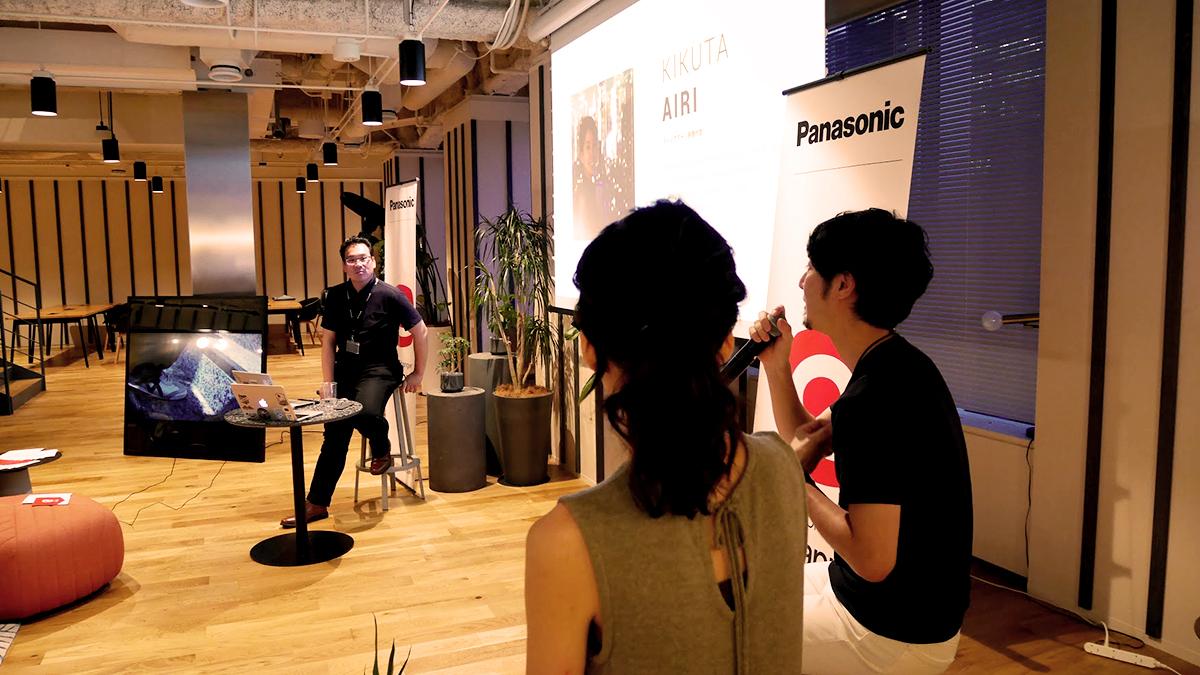 AMP was showcased at the venue.
AMP was showcased at the venue.
The difference between making and viewing visuals, and the future of images
Taniguchi: Over this first and second year since the Game Changer Catapult was launched, I've actively sought out discussions with creators. One comment that really struck me was that "Uploading something on Vimeo isn't an outlet." That made me aware of the distinctiveness of visuals. Works of painting art, for example, are painted pictures on canvass. Photos become works when they are shot and developed. In both cases what is made becomes the work. But visual works are different. Once you've made them, you have to find a way to play them. One way to do that is to put them on a visual platform for viewing on smartphones. That means the visual display performance is different to the creator's experience. That comment made me aware for the first time of difference between making and viewing visuals. As someone who actually makes works like these, what do you think about this, Ms. Kikuta?
Kikuta: First I have to fully grasp how the users will view it. These days I assume first of all that it's going to be viewed on a smartphone.
Taniguchi: Was that the same for the works being played today?
Kikuta: Yes, basically they'll be viewed on smartphones or on social media, though in some cases they're for store or station signage. That's why I make them assuming that small size.
Igarashi: Regarding how the viewer's experience is created, for example at WeWork we have a lot of pictures up as decorations, which we'd consider switching to AMP. With a device that generates visual art like AMP, people can view lots of created works, which will be a precious experience for creators. People might be inspired enough to find out the name of the maker and purchase it.
Taniguchi: You can see how it raises the value of living spaces for the people residing there, and creates a good relationship between those who make visuals and those who view them. If people get interested in finding out the makers and connecting to them, to form the starting line for creators to find their place in the world, which would definitely be an exciting thing. I hear that there are many good visuals and creators not well known yet in the world of video. There are so many works just kept in their creator's data storage and not worth anything yet. I hope we can create opportunities to bring these to light and give them value.
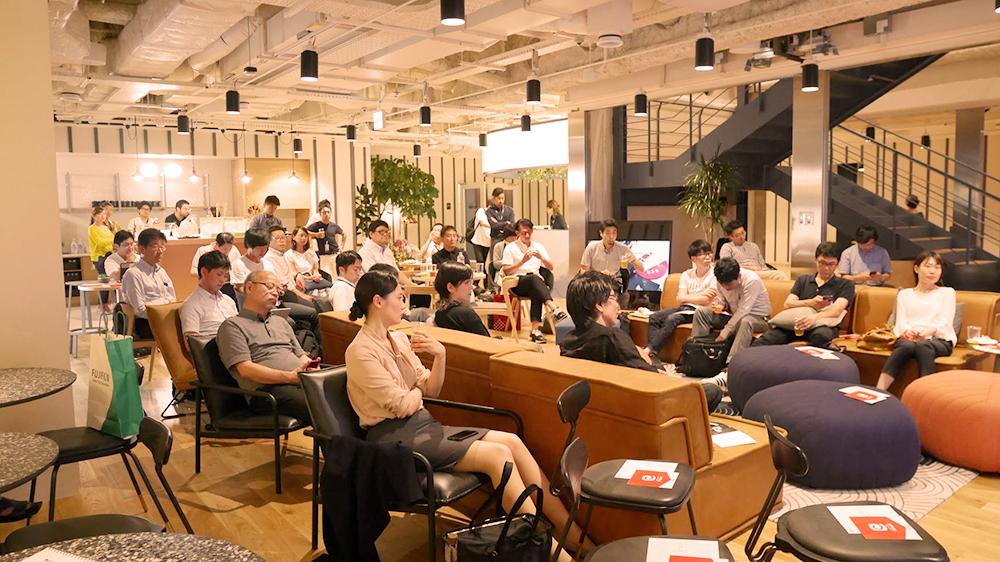
Taniguchi: I believe there are a lot of creators in the venue today, in part thanks I believe to the trend toward anyone being able to make visuals, as Mr. Igarashi pointed out. I think we can look forward to even more exciting things in the future as the act of creation becomes open in this way, so that what only special people could make before now becomes doable by anyone, in a sort of democratization. I think visuals will soon begin to be recognized as art as culture changes. I'm glad to have had this opportunity to talk to Ms. Kikuta as someone actually involved in creating these works, and to Mr. Igarashi of WeWork as someone involved in building a platform for creation of visuals. I hope we can work together in many ways in the future. Thank you for being here today.
Kikuta/Igarashi: Thank you very much.
-----------------------------
Airi Kikuta
Director/film maker
Profile: Born in 1988, she worked for five years as a VJ in a hip-hop club. She is skilled in particular in motion graphics, her works have been shown live at the Budokan and at the Tokyo Collection. She makes use of her sense of rhythm acquired through working as a VJ and studying abroad in New York to create a wide range of contents in various media, including brand movies primarily for the fashion and cosmetics industries, and in-store and street digital signage.
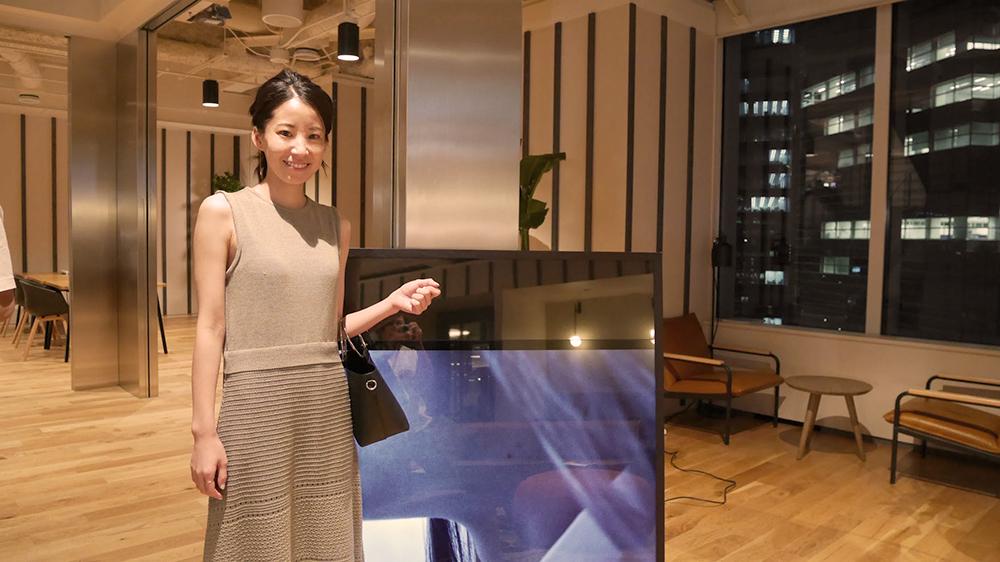
Noriyuki Igarashi
Representative director and president of CREARC Inc.
Profile: Born in 1978, he launched his own business last Christmas. This summer he will launch Totte, a sharing app specializing in photographic and video equipment.
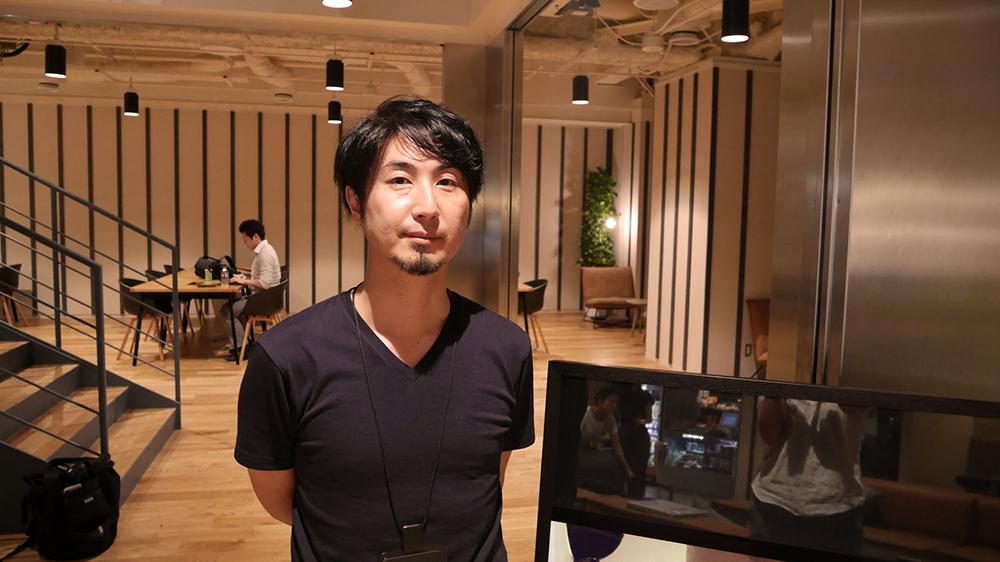
Akira Taniguchi
AMP project leader, Appliances Company, Panasonic Corporation
http://gccatapult.panasonic.com/ideas/amp-world.php
Profile: Born in 1977, he worked for ten years in Panasonic as a hardware engineer in the development of flat-panel TVs. His work mainly focused on the exterior design and overall structure of TVs, including the development of materials. Feeling a sense of crisis at the way prices soon fall even when good products are created, from 2014 he participated in new business projects, coming up with the core concept for AMP. From 2016 he shifted his field of action to the Game Changer Catapult. He is active in realizing business commercialization as the AMP project leader.
